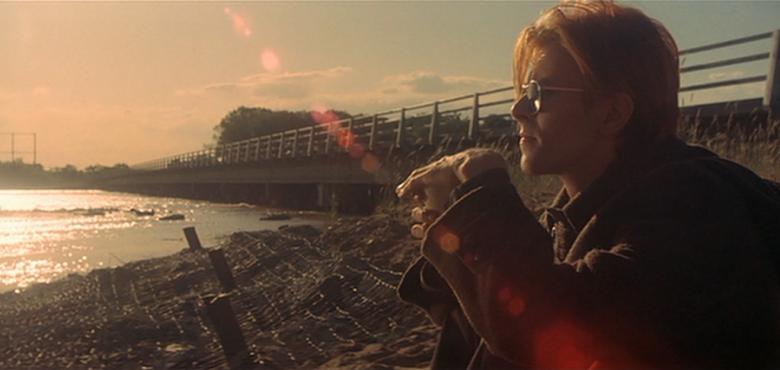Reviews
Nicolas Roeg
UK, 1976
Credits
Review by Victoria Large
Posted on 07 August 2011
Source 35mm print
Related articles
Reviews
The Man Who Fell to Earth (by Bernardo)
The Man Who Fell to Earth, Nicholas Roeg’s 1976 adaptation of a 1963 novel by Walter Tevis, is a film that is dreamy in a literal sense. Time passes strangely, with years gone in an instant, and not everything is fully explained. For these reasons it is a film that is particularly well-suited to theatrical exhibition - where viewers are immersed in the story as if in a dream - rather than the perilous, easily interrupted world of home video or the still-more-perilous, still-more-easily-interrupted worlds of cable television and Internet downloads. That is perhaps reason enough for The Man Who Fell to Earth’s current thirty-fifth anniversary theatrical rerelease (rolling through select US cities this summer and fall). The anniversary screenings also offer American viewers a chance to see Roeg’s director’s cut, rather than the censored version that unspooled in 1976, on the big screen, and may provide fans of slow-burning sci-fi a welcome, thoughtful respite from the buzzy, big budget event pictures that have come to dominate the genre.
Though often described as a fable about the ravages of wealth, power, and fame, one of the striking things about the film is how it brushes up against social criticisms without pressing them too aggressively on its audience. Yes, David Bowie plays Thomas Jerome Newton, an alien who comes to Earth with noble intentions only to lose track of them amidst terrestrial distractions like television, fancy toys, booze, and sex; but no one thing proves his undoing. Part of the film’s lingering power is the generalized nature of its discontent.
Like Taxi Driver, which also appeared in 1976 and is also making the rerelease rounds this year, The Man Who Fell to Earth brings us an America casually awash in images of commodified sex and violence. It’s an America that feels like, as Newton’s artless, earthy human companion Mary Lou might call it, “a very unhealthy place.” Newton’s bank of blaring televisions - a swirl of everything from classic era movies to lurid nature programs - creates a feeling of disorientation and even despair, the sensory overload rendering familiar media both overwhelming and bizarre. Newton’s continued unraveling is shocking, but his environment lends it a kind of inevitability. He is overstimulated, misunderstood, and finally betrayed—the more acclimated he gets to Earth, the more he seems to fall apart. The film’s best-remembered set piece (previously excised from American prints) finds Newton at his most hedonistic: wielding a gun while frolicking naked with Mary Lou, surrounded by an excess of food delivered by room service, he exudes spoilt child smugness and inner decay.
Of course, with Bowie in the role, Newton’s downward trajectory can easily be read as rock star-style excess and burnout, and if you squint at The Man Who Fell to Earth’s storyline, you might start to see the structure of a typical episode of Behind the Music. But it’s worth noting that this is only one facet of Roeg’s complicated film, one that resonates with greater sadness and uncertainty than a straightforward perils-of-fame story could. Newton’s disorientation seems to mirror that of the humans around him - flawed people who are trying their best and often getting it wrong. There’s of course Rip Torn’s libidinous scientist Nathan Bryce, an estranged family man whose life prior to meeting Newton is littered with personal and professional disappointment, and there’s Candy Clark’s heartbreaking Mary Lou, whose relationship with “spaced out spaceman” Newton does more to amplify her loneliness than erase it.
Alienation, is, quite fittingly, at the core of The Man Who Fell to Earth, which is perhaps what makes it so appropriate as David Bowie’s first leading movie role and arguably his most defining. Prepped by “Spaced Oddity” and Ziggy Stardust, it’s easy for us to buy Bowie as a literal alien as well as a being who is profoundly isolated from those around him. With his signature unmatched eyes, lacquered nails, and orange hair (which is, incidentally, one of my favorite hairdos in all of filmdom), Bowie looks like the provocative, androgynous glam rocker that he is, but he can also be read as someone who is trying very much to appear like an ordinary human and coming up short. And while the singer’s famous flouting of 1970s taboos regarding gender and sexuality are winked at here (Newton tells Mary Lou that he has visions of women and men, and slightly scandalized, she repeats, “Men?”), and make the film conducive to being read in those terms, such a reading is, again, too narrow to be entirely satisfying.
“The wilted stranger can be said to represent everyone who feels misunderstood, everyone who feels sexually immature or ‘different,’ everyone who has lost his way, and so the film is a gigantic launching pad for anything that viewers want to drift to,” Pauline Kael wrote once wrote of The Man Who Fell to Earth, her astute observation raising an important question: who hasn’t felt misunderstood, or at least wondered whether they had lost their way? “I wonder if we say and do the right things,” Bernie Casey’s shady businessman Peters says as the film is nearing its conclusion, and the open-ended musing might have belonged to any of this story’s characters. Newton may struggle with feeling comfortable in his human disguise, but when we see Mary Lou in an ill-fitting wig, or the camera lingers over her discarded fake eyelash, it reminds us that the Earthlings, too, are disguising themselves, squirming into unconvincing disguises and roles they were never meant for. Like the Icarus story, referenced here by way of Bruegel and Auden, Roeg’s trippy tale retains its relevance because we can see ourselves in his faltering hero.
We don’t do comments anymore, but you may contact us here or find us on Twitter or Facebook.



